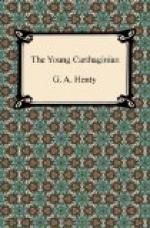Their Cretan archers, after shooting away their arrows with but small effect, for the strings had been damped in crossing the river, also fled behind the heavy troops; and these in turn were exposed to the hail of stones. Disorganized by this attack, the like of which they had never experienced before, their helmets crushed in, their breastplates and shields battered and dented, the front line of the Romans speedily fell into confusion. Sempronius ordered up his war machines for casting stones and javelins, but these too had been injured in their passage across the river.
The hail of Carthaginian missiles continued until the Roman light infantry were forced to fall back; and the slingers were then recalled, and the heavy infantry of the two armies stood facing each other. The Carthaginians took up close order, and, shoulder to shoulder, their bodies covered with their shields, they advanced to meet the legions of Rome. As they moved, their music — flute, harp, and lyre — rose on the air in a military march, and keeping step the long line advanced with perfect order and regularity. In the centre were the Carthaginian foot soldiers and their African allies, clothed alike in a red tunic, with helmet of bronze, steel cuirass and circular shield, and carrying, besides their swords, pikes of twenty feet in length. On the left were the Spaniards, in white tunics bordered with purple, with semicircular shields four feet in length and thirty-two inches in width, armed with long swords used either for cutting or thrusting.
On the left were the native allies, naked to the waist, armed with shields and swords similar to those of the Gauls, save that the swords were used only for cutting.
Sempronius brought up his second line to fill the intervals in the first, and the Romans advanced with equal steadiness to the conflict; but the much greater closeness of the Carthaginian formation served them in good stead. They moved like a solid wall, their shields locked closely together, and pressed steadily forward in spite of the desperate efforts of the Roman centre in its more open order to resist them; for each Roman soldier in battle was allowed the space of a man’s width between him and his comrade on either side, to allow him the free use of his weapon. Two Carthaginians were therefore opposed to each Roman, in addition to which the greater depth of the African formation gave them a weight and impetus which was irresistible.
While this fight was going on the Numidian horsemen, ten thousand strong, charged the Roman cavalry. These, much more lightly armed than their opponents and inferior in numbers, were unable for a moment to withstand the shock, and were at once driven from the field. Leaving the elephants to pursue them and prevent them from rallying, the Numidian horsemen turned and fell on the flanks of the long Roman line; while at the same moment the Carthaginian slingers, issuing out again from behind the main body, opened a tremendous fire with stones heated in furnaces brought to the spot.




